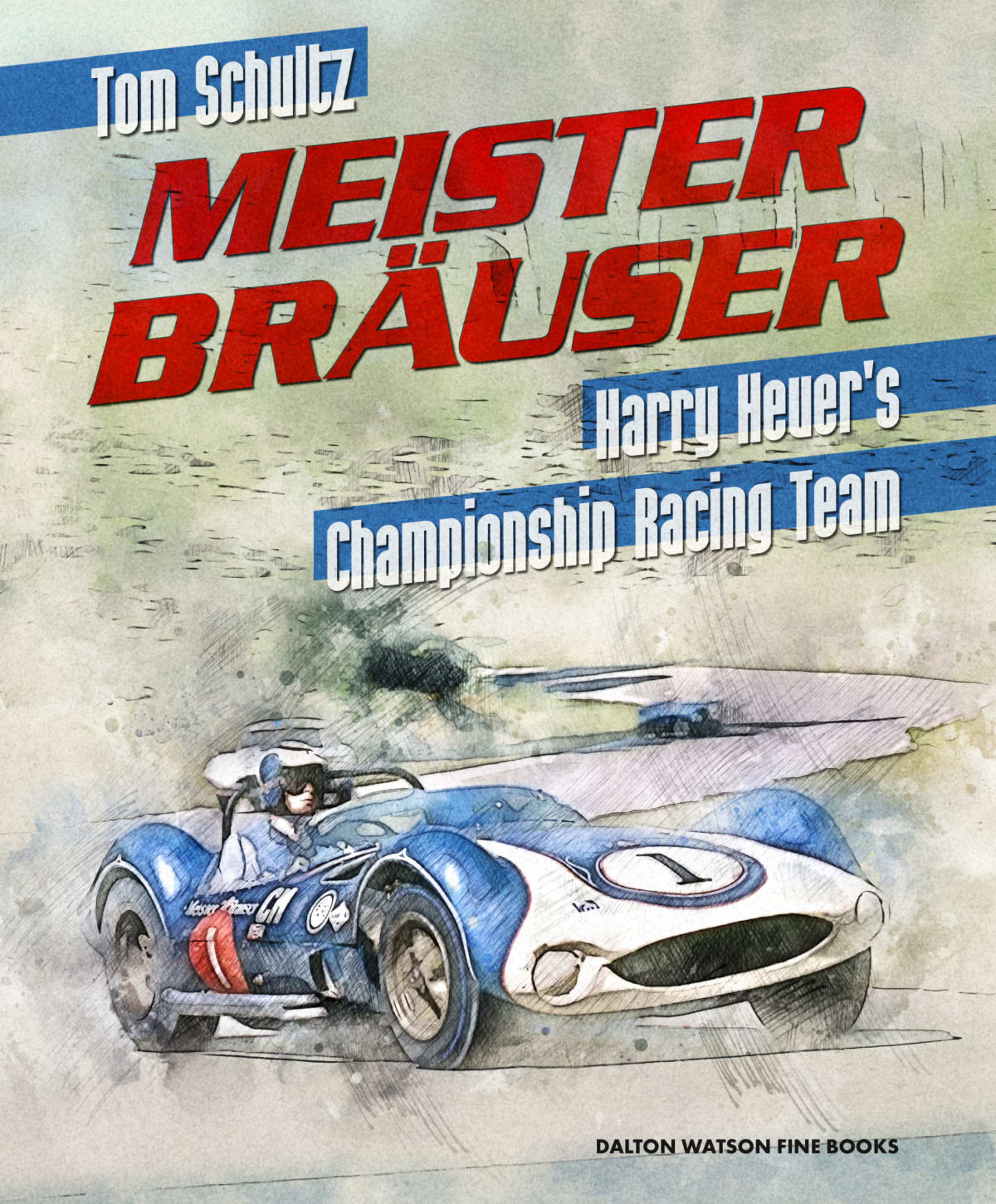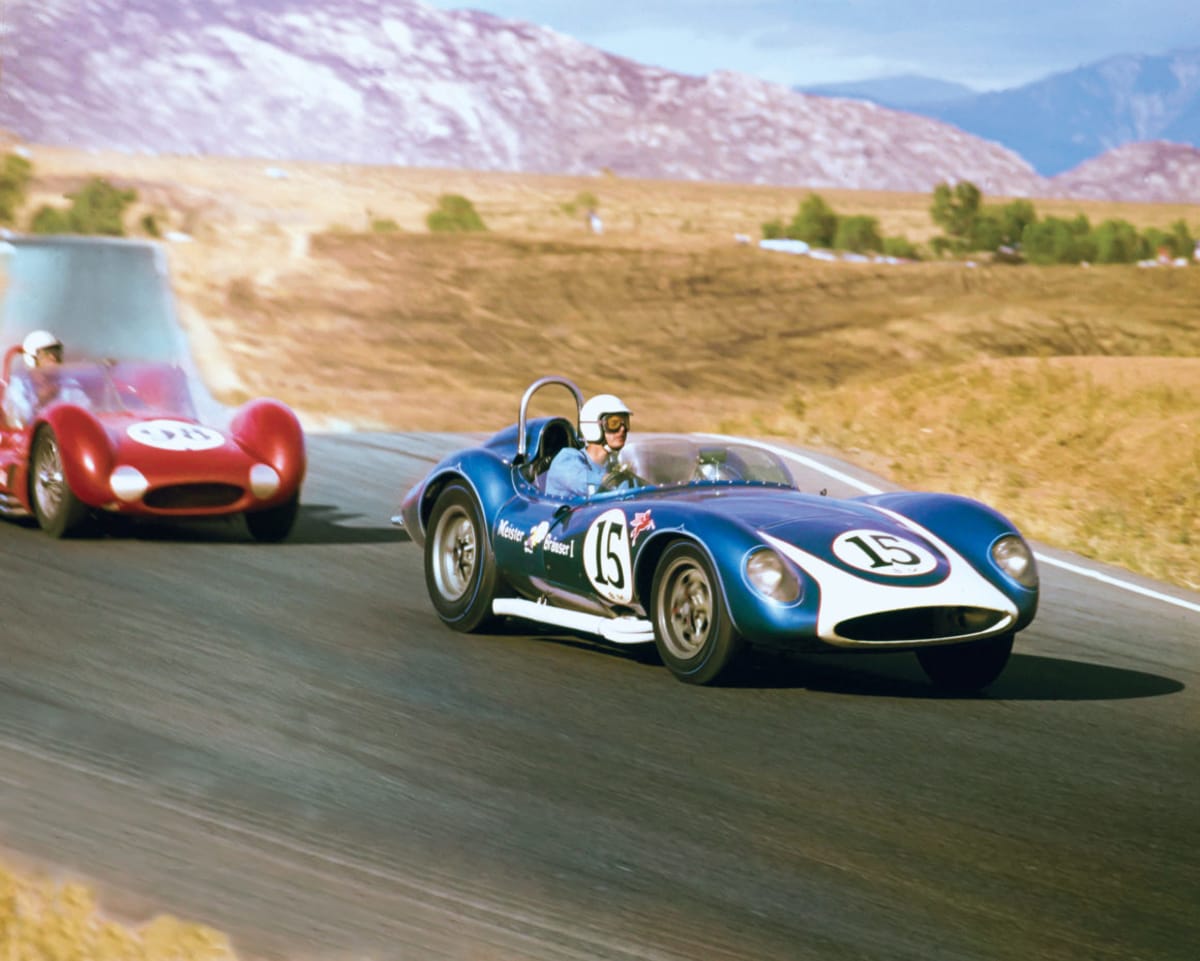MEISTER BRAUSER Harry Heuer’s Championship Racing Team
Published on Sun, Feb 23, 2020
By: Doug Stokes
LACar Book Review
MEISTER BRAUSER
Harry Heuer’s Championship Racing Team
by Tom Schultz
Forward by Jim Hall
Publisher: Dalton Watson Fine Books – 2019
Deerfield, IL 60015 USA
324 pages / 370 photos
ISBN: 978-1-85443-304-6
$95 USD

In a way, this handsome new book takes up and greatly expands the story of one of the most fabled American racing sports cars, the Reventlow Scarab, a saga that was begun with Preston Lerner’s seminal 1991 book about the machines that was sub-titled: “Race Log of the All-American Specials,1957-1965”.
Simply put, this is the story of a young man with a passion for motorsports that took his dream to national racing Championships while having a great time doing it racing against and with the very best drivers of the day. In a more complex sense, it’s the tale of the first wave of outright professionalism in the previously “pure” amateur sport.
First, a word about the car, the Scarab. Considered by many as the most beautiful racing car ever, and named for an Egyptian dung beetle, the brilliant electric blue Scarab was a wonderful California concoction that combined the millions of the heiress to the Woolworth fortune with her son Lance Reventlow’s ambition to beat the European racing car builders at their own game, the chassis design talent of Ken Miles, the artistic talent of a young Art Center student, the distinctive pin-striping of Von Dutch, and an all-star team of fabricators and engine builders… many of whom went from Reventlow Automobiles, Inc. to work for Carroll Shelby and then on to Dan Gurney’s Eagle operation, building world-beating racing machines at every stop.
Virtually every photo of the sleek Scarabs in “Meister Brauser” shows the car in its classic nose-high stance, always seeming to be accelerating hard, almost leaping forward. There was always a sense that these cars, with their long hoods and driver mounted in the curvaceous rear section, were almost too beautiful to be fast … but they damn well were and this book covers that side of the ledger with the stories of every race that the Meister Brauser team took part in from 1959 until 1963.
Harry Heuer, was a young executive at the Peter Hand Brewing Company who sold beer under the “Meister Brau” label, the Special Assistant to the President, he was introduced to racing by the company’s connection as the official beer of the 3.27-mile long Meadowdale International Raceway, located just a few miles outside of Chicago in Carpentersville, Illinois. Enthused about sports car racing, Heuer quickly got involved in local amateur competition and the die was cast.

… Mister Heuer went out and bought himself a race car … what was then called a “special”, a purpose-built racing sportscar a light, tube-frame, fiberglass-bodied racing car called a “Bocar XP-5” and built by a fellow named Bob Carnes out of Denver, Colorado. It was a hulking creature with a fiberglass body, wire wheels and a Chevy V-8 up front under the hood, a combination that got him into his first big race at Meadowdale.
Complicating matters a bit, the bank that Heuer had taken out a loan to buy the car with got a bit skeptical about what he was doing with the money that he got from them. He smoothed that out, but realized that the old saw: “…Speed costs money, how fast do you want to go?” was an immutable fact of racing, and he wanted to go fast.
It was not long after that, that Heuer found himself in front of the Peter Hand Board of Directors, pitching the idea of a sports car racing team that would carry the Meister Brau name to great glory and national championships. This book is the road map of how it was done and attests to the fact that Heuer followed through with his promises, delivering national championships for the brewer in 1960, 61, 62, and 63. The fact that he was the son of the company’s president may well have weighed in that decision, but, for a number years, it was considered by many top Peter Hand executives as a sound one as well.
As fate would have it, the Reventlow operation, having won everything that there was to win in North American sports car racing, was changing gears and becoming fully involved in a new quest … Formula One racing in Europe. They put out the word that two of the sports cars were up for sale. Heuer, who had seen a Scarab win the inaugural race at Meadowdale moved quickly and bought both of the blue beauties, brought them East, kept the Von Dutch paint job, rechristened them: “Meister Brauser I” and “Meister Brauser II” … and went racing.

That story is well told in this 324-page book that’s about as well designed and illustrated as one could be, with hundreds of crisp black and white racing and pit action photos set off by an array of color photos, a number of which are full two-page spreads.
Author and historian, Tom Schulz offers a well-chosen bibliography, index, and full appendices that cover the full Meister Brauser team race record (date, driver, car # track, event, and finishing results); the drivers who drove for Meister Brauser (Heuer, Augie Pabst, Don Devine, Jim Jeffords, Lance Reventlow, John Kilborn, Carroll Shelby, Bill Wuesthoff, Denise McCluggage, Dick Rathmann, and Don Yenko) and the “log” of the cars themselves by chassis number.
(If I may inject a bit of personal reviewing behavior here … I must admit that the first thing I do upon picking up any serious/non-fiction book is turn to the index. For me, the old saw about being about not judging a book by its cover is often borne out in the read. And that’s not always a bad thing … I’ve read many excellent books with unimaginative, drab covers and have been disappointed by a few that made upfront promises that the contents could not keep. That’s why I first take a look at the cast of characters in the index.)
This book as a v. good index … here’s just a quick taste of the well over 300 people that you’ll run across in “Meister”: Max Balchowsky, Briggs Cunningham, Roger Penske, Jim Hall, Bob Bondurant, Phil Hill, Dan Gurney, Dick Troutman & Tom Barnes, both Dick & Jim Rathmann, Chuck Daigh, and Sir Stirling Moss, with Cary Grant* and Roy Rogers* (yeah, THAT Roy Rogers) both thrown in for good measure.

Back to the review: As it revs up this book tells the story of the beginnings of professional sports car racing in America. From its earliest post-war years, sports car racing was an amateur sport. Not sullied with prize garish prize money, the races were still for championships, bragging rights, and silver-plated trophies. Wealthy “sportsmen” took part, some racing themselves, and many loaning out their machines to more experienced drivers, who, like jockeys, “exercised” and raced the cars. No prize money was paid, but top drivers had their “expenses” taken care of and other ways of (non-reported) remuneration were often part of the deal.
The Meister Brauser team was right on the leading edge of sports car racing’s shift to a more realistic professional form, as readers will observe from the photos, sponsor’s names begin to creep in, and supplier stickers that now almost obliterate any sort of color scheme or paint design, starting to make what seem like shy appearances (tire brand, spark plug, oil company) on cars’ flanks.

This one is about a heady time in American sports car racing, huge crowds, fantastic (for the day, anyway) purses, national recognition in the buff books and early validation from mainstream sponsors like the Los Angeles Times, the LA Examiner, Goodyear, and Pure Oil. New tracks were built, older tracks updated, and the roots of what later became the vaunted Can-Am Series and the International Motorsports Association (“IMSA”) were planted.

Augie Pabst’s Meister Brauser Scarab leads Carroll Shelby’s
Birdcage Maserati up the hill and into turn 7.
Sadly, the end for the Meister Brauser Racing Team was not a happy one. As he often did, on February 1, 1964, Harry Heuer flew the company DC-3 back to Chicago from a race in Augusta, Georgia. The plane had some problems that kept it on the ground for some time before taking off for home. The team transporter crew had left on time drove straight through and arrived back at the race shop to find it: “empty, bare, nothing left … the milling machine, the bodywork materials, all the welding equipment, everything gone…”.
The Peter Hand Board capriciously, and without so much as a word to Heuer, not only shut his racing operation down but had summarily removed all traces of its very existence.
Author Schultz: “It was an act devoid of basic decency. The Board of the Brewery apparently had decided that the racing program was costing too much money and was not worth continuing, but the way they went about it was the ultimate in dirty play and the height of cowardliness. The Board lacked the decency and simple manners to confront Heuer directly and explain the situation and the apparent necessity to him. They chose to simply stab him in the back.”
The Meister Brauser racing team was gone, the shop closed, the spectacle at an end, the, if nothing else resilient, Heuer started his own commercial air charter company (with himself as one of the pilots) flying Lockheed Constellations people and cargo all over Central and South America.
Happily, the story really doesn’t end there. Appendix 4 is devoted to the spirit that the Scarabs and the Meister Brauser Team so infused racing fans with over the years and there’s a joyful telling of the reunions that have taken place over the years. By the 2008 reunion at Road America, hair had turned silver and gaits were not as swift, eyesight was not as keen … but the stories flew and the good times were well celebrated by many of the original Scarab and Meister Brauser team members and their legions of fans.
And the cars? Renewed to their prime, they were as beautiful, brutal, and totally intriguing as they were the first time that anyone ever laid eyes on one.
All in all, it’s a good way to close this beautifully-presented book. Harry Heuer passed away at age 94 on May 25, 2019, and I don’t think that he could have ever wished for a better tribute. -DS
*Cary Grant was, for a time, Scarab patron Lance Reventlow’s stepfather, having married Reventlow’s mother Barbara Hutton, who inherited 70 million dollars at age 5. Grant was the third of the Woolworth heiress Hutton’s seven husbands.
And … movie cowboy *Roy Rogers was a guest at a sportscar race at Riverside and was apparently the first person to notice that one of the Scarabs that had been entered in the race had its fuel tank punctured in a starting line accident which caused the car to be disqualified the great dismay of young mister Reventlow.
Side Bar: THIS ONE IS PERSONAL
by Don Taylor
Much has been written about the Scarabs from a West Coast perspective. All the glamour of Reventlow and his all-star team of California ‘hot rodders’, and their 1958 winning season highlighted by Chuck Daigh’s victory at Riverside over Phil Hill and his Ferrari, created a heady time.
But when two of the three cars were sold and they left Southern California, for many they had all but disappeared. “Where Did The Scarabs Go?” was the title of a cover story in Sports Cars Illustrated, written by Dic Van der Feen, April 1960. Meister Brauser Harry Heuer’s Championship Racing Team tells what happened after “Act 1”.
LACar.com Editor Doug Stokes was lucky enough to see them in all their glory in their opening act. He was there, at 11928 W. Jefferson Boulevard in Culver City, a high school kid from Covina, watching them being built. And he watched them premier and star in their West Coast outings.
Meanwhile, as a young lad, I first saw the cars raced by Reventlow and Daigh when they came to Meadowdale Raceway in the summer of ‘58. I immediately fell under their magical spell.
I didn’t know it at the time, but like Doug, I too would get to know the Scarabs up close and personal, Just as they were starting their “Second Act”, which lasted much longer than their first. Growing up in Chicago, far from the ‘City of Speed’ (as Joe Scalzo titled his book about race car building in the LA area) I really was not expecting it.
But one night I spotted a purple and white race car under the lights on display in the showroom of a local Chevrolet dealer at 4501 Irving Park Road, Nickey Chevrolet. I quickly realized this was not a Maserati 450, nor a Ferrari, but a Scarab, right here, right in my own neighborhood. Wow! It wasn’t long before both cars were rejoined at the Meister Brauser team, also located near me, not in the suburbs, but right in the city proper.
Somehow I talked my way into visiting the team’s shop one day, located in a maintenance garage on the Peter Hand Brewery complex. After that, having made friends with the crew, I’d frequently ride my bike down there after school. And hang out, and observe. I’d see the cars disassembled, memorizing every tube in the frame, every component, all the plumbing, and of course the precious alloy bodywork, which was quite limber when removed.
The team’s expert body man, Bill Leahy maintained and painted the aluminum shell, openly sharing with me what he was doing. The crew chief, Willy Weis took the time to talk about wheel bearings and brakes. Crewman Jack Choice snuck me into the pits at the races. One time, at the races at Road America, I slept overnight in Siebkens Resort’s parking lot in Elkhart Lake. And, race rig driver Richard Ex showed me the gun he kept hidden…the team’s race shop wasn’t in the best neighborhood.
That all turned out to be the greatest experience for a barely-into-my-teens guy like myself: getting to know the crew, seeing the dynamics of a race team, and watching them work with their hands.
It exposed me to the wonderful characters that racing attracts, along with their stories and antics. They demonstrated another way to live. My experiences with the Meister Brauser Racing Team taught me a lot at the right time and helped set a direction for my life and career.
Thanks Tom Schultz, for helping me, and others like me, relive that time. -DT




